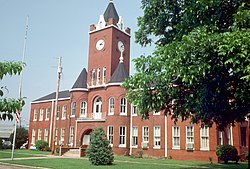Elba | |
|---|---|
 Coffee County Courthouse in Elba | |
| Nickname: The City of Flowing Wells | |
 Location of Elba in Coffee County, Alabama. | |
| Coordinates: 31°24′32″N86°05′50″W / 31.40889°N 86.09722°W [1] | |
| Country | United States |
| State | Alabama |
| County | Coffee |
| Settled | Early 1830s |
| Incorporated | April 13, 1853 |
| Government | |
| • Type | City Council/Mayor |
| Area | |
• Total | 15.42 sq mi (39.93 km2) |
| • Land | 15.34 sq mi (39.73 km2) |
| • Water | 0.081 sq mi (0.21 km2) |
| Elevation | 190 ft (58 m) |
| Population (2020) | |
• Total | 3,508 |
| • Density | 228.7/sq mi (88.31/km2) |
| Time zone | UTC-6 (Central (CST)) |
| • Summer (DST) | UTC-5 (CDT) |
| ZIP code | 36323 |
| Area code | 334 |
| FIPS code | 01-23296 |
| GNIS feature ID | 2403549 [1] |
| Website | www |
Elba is a city in and the county seat of Coffee County, Alabama, United States. It is the official seat, although there are two county courthouses, with the other one being located in the city of Enterprise. At the time of the 2020 US Census, Elba's population was 3,508. [3] Elba is part of the Enterprise micropolitan statistical area.


